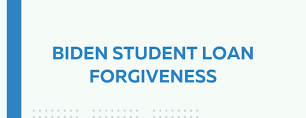In recent years, student loan debt has emerged as a significant economic challenge for millions of Americans. Recognizing the burden this places on individuals and families, President Joe Biden has taken steps to address the issue through various initiatives, with student loan forgiveness being a key component of his agenda. In this comprehensive guide, we’ll delve into the intricacies of the Biden Student Loan Forgiveness Plan, exploring its key features, eligibility criteria, and the potential impact it could have on borrowers nationwide.
Understanding the Biden Student Loan Forgiveness Plan:
1. Background and Context:
To comprehend the Biden administration’s approach to student loan forgiveness, it’s crucial to understand the context of the student debt crisis in the United States. With total student loan debt surpassing $1.5 trillion, many graduates face the daunting challenge of repaying loans that can take decades to clear. President Biden’s plan aims to alleviate this burden, providing relief to those struggling with the financial repercussions of pursuing higher education.
2. Key Features of the Plan:
i. Broad Debt Cancellation:
One of the central pillars of the Biden plan is the proposal for broad debt cancellation. This initiative is designed to forgive a substantial portion of federal student loan debt, offering relief to borrowers across income levels. The specifics of the cancellation, such as the maximum amount forgiven and the income thresholds for eligibility, are critical aspects that borrowers should closely monitor.
ii. Income-Driven Repayment Adjustments:
The Biden administration has expressed a commitment to reforming income-driven repayment (IDR) plans. This involves simplifying these plans and ensuring that borrowers never have to pay more than 5% of their discretionary income towards their student loans. Understanding the changes to IDR plans is crucial for borrowers seeking long-term, manageable repayment solutions.
iii. Public Service Loan Forgiveness (PSLF) Enhancements:
The Public Service Loan Forgiveness program, designed to forgive the remaining balance on direct loans after 120 qualifying monthly payments under a qualifying repayment plan while working full-time for a qualifying employer, is set to receive enhancements under the Biden plan. Borrowers engaged in public service professions should pay close attention to these proposed changes, which could significantly impact their eligibility and forgiveness amounts.
3. Eligibility Criteria:
Determining who qualifies for the Biden Student Loan Forgiveness Plan is a critical aspect of understanding its potential impact. While the plan aims to be inclusive, certain criteria, such as income thresholds and the type of federal loans eligible for forgiveness, will play a crucial role in determining eligibility.
4. Potential Impact on Borrowers:
The Biden Student Loan Forgiveness Plan has the potential to reshape the financial landscape for millions of borrowers. From reducing monthly payments to offering substantial debt relief, the plan aims to provide tangible benefits that extend beyond individual borrowers to stimulate economic growth at a broader level.
Conclusion:
As the Biden administration continues to navigate the complexities of student loan forgiveness, it’s essential for borrowers to stay informed and proactive. By understanding the key features, eligibility criteria, and potential impact of the Biden Student Loan Forgiveness Plan, individuals can make informed decisions about their financial future. As developments unfold, keeping a watchful eye on updates and changes to the plan will empower borrowers to navigate the evolving landscape of student loan debt with greater confidence and clarity.

